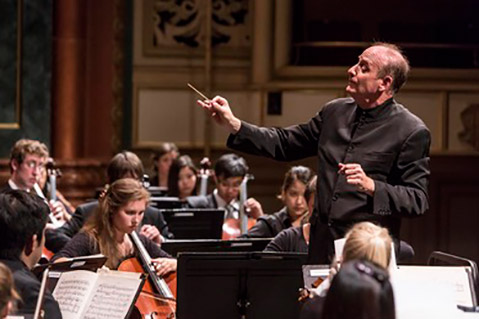Music Academy of the West’s Festival Strong Second Show
The Academy Festival Orchestra presented Bolero at the Granada Theatre

The Music Academy of the West’s Academy Festival Orchestra (AFO) held down the fort at the Granada Theatre and laid down the tutti forte with cannonball gusto. Conductor Larry Rachleff’s prestissimo pace and telepathic cueing delivered a warm, tight, and punchy sound, making AFO’s performance of Berlioz’s Overture to Beatrice and Benedict, Ravel’s Boléro, and Rachmaninoff’s Symphonic Dances action-packed.
For those not familiar, the Music Academy of the West (MAW) conservatory has an eight-week grooming summer program for students and recent graduates of top-ranking music schools such as Juilliard, Thornton, Rice, Eastman, Colburn, and even international programs. Those selected are the crème de la crème of up-and-coming classical musicians, and MAW offers them full scholarships, a boot camp of master classes, and the chance to enter the symphonic major leagues.
Saturday night’s program featured golden nuggets from masters who are known for their advancement of orchestration: Berlioz for his dream-like Symphonie Fantastique and his Treatise on Instrumentation, a book on the technical study of instrumentation; Ravel for Boléro and his creative arrangement of Mussorgsky’s piano suite Pictures at an Exhibition; and Rachmaninoff for his cleverly structured, moody Piano Concertos I, II, III, and IV.
With maestro Rachleff’s Hollywood-style conducting, the evening took on a cinemascopic aura. In Berlioz’s Overture to Beatrice and Benedict, I was first transported to English meadows with plum trees, and then when Rachleff turned up the heat, the shredding strings and two-handed marching-band arm thrusts pumped the orchestra into an Indiana Jones frenzy.
Ravel’s Spanish-themed Boléro evoked a sensual 10/Chariots of Fire explosion as the conductor nodded his head, psychically cuing the soft snare drum and then passing the melodic torch to the woodwinds, the brass, and so forth, with the melody ever so slightly building into crescendo and changing timbre like a circular wall of mirrors. As the music grew, it evolved into an aural Lawrence of Arabia with cinematic strings, timpani, and brass. The tutti orchestra, urged on by Rachleff’s karate chops and head jolts, finally climaxed with raucous cymbal crashes and forte brass that made the audience go wild.
Rachmaninoff’s Symphonic Dances were an epic dance-to-the-death with machine-gun timpani. B-b-b-b-b-bum! In later passages, the remarkably tight violin section was so synced that I could hear their vibratos line up to one degree of a millihertz in separation; you could see 50 fingers bend their strings in perfect harmony. It was incredible.
The conductor pushed the thoroughbred musicians with no hesitation, and the results were amazing and bravissimo!



